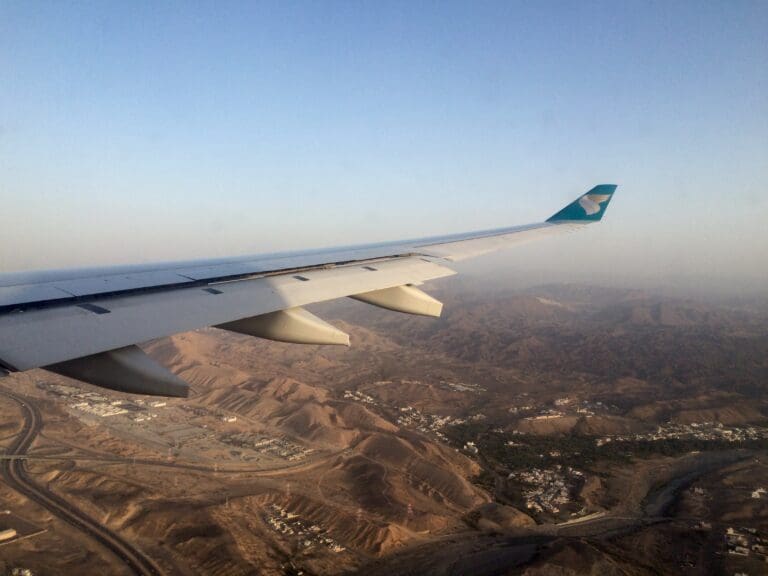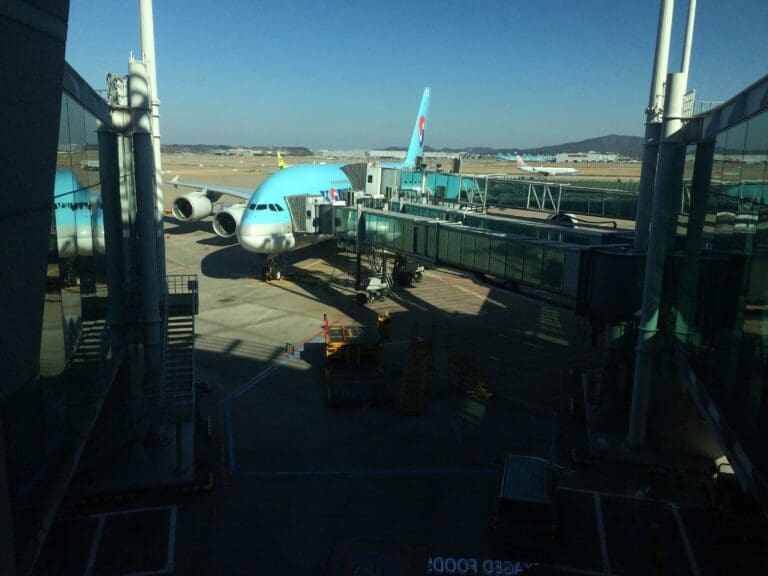Remembering Meridiana and Their MD-80s: Olbia to London Gatwick

You can skip to the flight by clicking here
Meridiana was a Sardinian carrier with a global presence. Formed by Aga Khan IV as Alisarda, the airline initially focused on connecting Sardinia with the rest of Italy, and later destinations across Europe. Rebranding as Meridiana in 1991, the airline continued to expand, and following its merger with leisure carrier Eurofly in 2006, for a time this served as Italy’s second-largest airline and served a mixture of short, medium and long haul destinations. However, in September 2017, Qatar Airways purchased a 49% stake in Meridiana’s parent company, AQA Holding. As a result, the Qatari giant would lead an initiative that would result in Meridiana’s total rebrand, alongside a fleet revitalisation project that aimed to reinstate the carrier’s position as a major player in the Italian airline industry.
In March 2018, Meridiana transformed into Air Italy and expanded its route network, in total operating to 35 destinations across Brazil, Canada, Cuba, Egypt, Ghana, India, Italy, Kenya, the Maldives, Nigeria, Russia, Senegal, Spain, Tanzania, the UK and the USA. Powering this development, the carrier added four Airbus A330-200s and three Boeing 737 MAX 8s, supplementing the Boeing 737NGs that had been passed down from Meridiana. However, things were not exactly plain sailing and Air Italy suffered from a number of financial woes, with these not assisted by the groundings of the Boeing 737 MAX, the type that had been planned to become the mainstay of the airline’s fleet. Unfortunately, following less than two years of operation, the airline ceased operations in February 2020, bringing a sad end to the carrier and the legacy of Alisarda and Meridiana.
Come with me back to October 2017 as I fly with Meridiana in their last few months of operation, and on one of their rare McDonnell Douglas MD-80s just weeks before the type was retired.
Background
Back in 2001, despite having little interest in aviation, I vividly remember peering through the gate windows at London Heathrow and down upon what seemed to be a rather peculiar-looking jet. Despite its design harking from an era when the idea of space travel was all the rage, this was no space rocket but instead was an Iberia McDonnell Douglas MD-80, with this taking me down to Seville on a family holiday. Nine years later, and my interest in aviation having fully formed, I was lucky enough to get the opportunity to sample the delights of the Mad Dog when I flew from St Petersburg to Heathrow with a stop in Copenhagen, with both legs operated by comfortable Scandinavian Airlines McDonnell Douglas MD-82s. At that time I realised that the aircraft was most certainly rarer than an Airbus A320 or a Boeing 737, and very much a dying breed with these being on their way out at major European operators such as Alitalia, Iberia and Scandinavian Airlines.
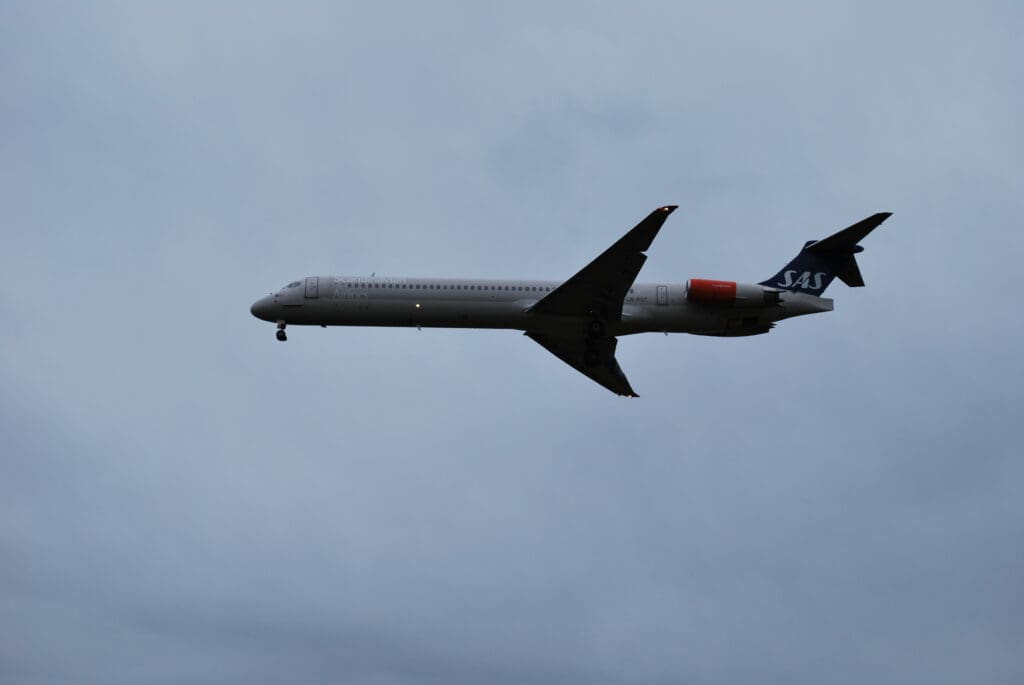


Upon moving to Korea for a year in 2016, I did manage to catch a flight on Northeast Asia’s only McDonnell Douglas MD-80 operator, the now-defunct Taiwanese carrier Far Eastern Air Transport, riding this on a short route from Taipei Songshan to Makung. Once back in Britain in August 2017, with just a small handful of European carriers operating the type, many of which focused on ACMI and charter operations, I initially thought that catching a ride on one of these old pencil jets would prove to be rather difficult.
So, how did I manage to catch a flight on the MD-80?
In September 2017 I found myself stranded in Birmingham Airport. From there, I booked to fly with Brussels Airlines to Brussels on the rare Sukhoi Superjet and then onwards to Turin on an Embraer 145, with these being CityJet and BMI Regional operated services respectively. However fog in Brussels had thrown a slight spanner in the works, the late arrival of the Superjet ensuring I would miss my connection in Belgium. Still hoping to make the trip down to Turin, and, seeing as I did not receive much help from Brussels Airlines, I used my initiative to hunt out alternative options. One potential option was to fly from London to Olbia with EasyJet and then connect onto a Meridiana service to Turin, with the second leg operated by the rare McDonnell Douglas MD-80.
Despite being fully aware that Meridiana had been a long-time operator of the McDonnell Douglas MD-80, I had held the incorrect assumption that the airline’s remaining examples had been replaced by Boeing 737NGs. Whilst I ended up abandoning my plans to reach Turin, this led me to undertake some research on Meridiana’s McDonnell MD-80 fleet, and I soon discovered that the airline’s four remaining examples of the type would bow out of service a little over a month later on the 31st of October 2017. This would mark the end of McDonnell MD-80 operations in Italy, coming just under 34 years after the first example was delivered to Alitalia in December 1983.
Unsurprisingly, I was initially first drawn to the idea of catching Meridiana’s very final McDonnell Douglas MD-80 operated service, which was scheduled to take the form of flight IG1116 from Rome Fiumicino to Olbia. However, arriving in Sardinia at 2230, the entire flight would take place in darkness, whilst one-way tickets on flights between the two cities that day started at €60.80 which seemed to be a little pricey given the fifty-minute flight time. Finally, having fallen victim to several last-minute equipment swaps in 2017, I was fearful that this may have occurred on this flight too.
After doing some searches on Meridiana’s stylish and easy-to-use website, I soon discovered that the type would be deployed on the airline’s thrice-weekly service between Olbia and London Gatwick throughout October 2017, replacing the usual Boeing 737 on the route. This was around 5.5 times longer in distance than the service between Olbia and Rome, and, with one-way tickets costing just €30.82, this proved to be a very economical option. Thus, with little hesitation, I went ahead and booked this, parting with an additional €4 to select Seat 35E at the rear of the aircraft near the McDonnell Douglas’ mighty right-hand engine. Overall, I found booking via Meridiana’s website to be quick and easy, and I encountered absolutely no difficulties whatsoever during the booking process.
The Flight
Olbia Costa Smeralda Airport sits around three kilometres to the south of the centre of Olbia. Being Sardinia’s second busiest airport and the relatively short distance that separates this from the town, one would assume that transport between the two is straightforward and cheap. Whilst there are indeed a number of buses that run between the airport and the town centre, having regrettably failed to research these before leaving Britain, unable to connect to the airport’s wifi upon arrival, lacking a SIM card that worked in Italy and with virtually no information on these available at the airport, following my arrival in Olbia, after attempting to find out about the bus services I ended up taking an ‘official’ taxi to my hotel in the centre. Whilst this was most certainly a licenced car, I ended up being charged the tourist rate and this ten-minute ride set me back an eye-watering €20, just €10.82 less than my flight from Olbia to London! Opting not to dispute this with the rather bulky and tough-looking driver who sported a large gold chain and two hands full of signet rings, once in the town I handed over the €20 with no complaints and made my way to the hotel.
Having gone for one of the cheaper hotels in the town centre, this lacked staff and wifi and so I ended up being equally clueless about returning to the airport the next morning for my flight back to London. Following a short night’s sleep in a boiling hot hotel room, I woke up at 0545 and following a quick shower, I made my way out of the hotel at 0600, immediately being greeted by the pleasant and refreshing Sardinian autumn air. With neither a taxi nor a bus stop in sight, I decided to attempt the journey on foot. At that time, the dark streets of Olbia were almost completely deserted with only the occasional street cleaner seen tidying before the streets were illuminated by the morning sun. After heading down Olbia’s main strip, I walked along the small harbour taking in the scent of the sea before crossing over a small bridge and making my way through what seemed to be an ordinary residential area. For the first two-thirds of the journey, all appeared to be going well as I slowly edged towards the airport. However, eventually, I reached a large roundabout where I found that all roads that led to the airport appeared to lack pavements. Fortunately, I soon discovered a bus stop where the digital display indicated that an airport-bound bus would appear in several minutes. This arrived in the form of a small minibus and several minutes later, I was transported up the hill to the airport. Looking outside, a new day was dawning, with the morning sun filling the sky with a fantastic orange and red glow.

Following a short five-minute right, the minibus pulled up to the airport’s terminal building where I disembarked along with a cluster of airport workers and fellow travellers. From the outside, the terminal does not feature any particularly notable or remarkable architectural features, consisting of a building that resembles a long white box. However, once inside, I found the landside portion of the terminal building to be spacious and modern, complete with high ceilings that create a rather nice and spacious aura. However, the sense of space was undoubtedly perpetuated by the fact that there seemed to be few passengers milling around inside that morning. In terms of facilities, this portion of the terminal featured a good number of shops and cafés, however, most of these were closed upon my arrival. Soon, I arrived at the spacious check-in hall that sits at one end of the terminal, above which, a preserved Alisarda Beech C-45F Expeditor, I-SARE, takes pride of place and dangles down from the ceiling above a bank of check-in desks. Overall, the check-in hall left me with few complaints, however, some of the signage appeared to be a little outdated and I spotted a fair number of branding for the Italian low-cost carrier Wind Jet who had halted operations over five years before my flight!



Being the hometown airline and the largest carrier at the airport by far, it came as no surprise to find plenty of Meridiana branding located through the check-in hall, whilst the airline also enjoyed its own dedicated check-in desks running along one side of the hall. At first glance, half of these desks appeared to be busy, however as I approached these it turned out that these desks were being utilised for Eurowings’ two morning flights to Germany. Whilst I could have checked in online, seeing as I already had an assigned seat, I decided to save this until I had arrived at the airport. To my delight, I was able to wander straight up to a Meridiana desk where I was promptly given a warm and friendly greeting first in Italian and then again in English by one of the airline’s staff members. Following the usual typing, it wasn’t long before my Olbia Airport-branded boarding pass was handed over to me after which I was free to head through to the airside area.

Having buckets of time on my hands, I was in no rush. However, with little to do in the landside area, I decided to make a beeline for security. Just like back home in Britain, passengers can pay an additional fee to use a fast lane at security, however, with nothing more than very minimal queues, there would have been absolutely no point in doing so and I sailed through with no issues in around three minutes. Once through security, all passengers must pass through a duty-free shop selling the usual range of products alongside local souvenirs and produce, before arriving in the main airside waiting area. Turning to the main airside waiting area, this was a little shabbier than the landside area, however, this was relatively clean and tidy, whilst a good number of charging points could be found and the complimentary wifi worked without issue.
Aviation enthusiasts will be glad to hear that large windows offer great views of most stands and the runway in the distance. After wandering around, I plonked myself down at watched the variety of movements outside as the sky transformed from red to yellow as the sun continued to rise over the Mediterranean. Outside, upon arriving in the airside area a Eurowings Airbus A320 could be seen being readied for its return flight to Germany, which was soon joined by another of the airline’s Airbuses. Meanwhile, a more interesting Meridiana McDonnell Douglas MD-82 could be seen being towed to a gate in preparation for its short domestic hop to the Venetian city of Verona in Northern Italy. Meanwhile, I also spotted a Boeing 737-700 operated by the TUI Group’s Belgian arm, Jetairfly, touching down from the Northern French city of Lille. Given the small size of Olbia, home to around 60,000 residents, its airport is far from Italy’s busiest, and operations swell during the summer months with the airport serving the popular Costa Smeralda.


With the United Kingdom not being part of the European Union’s Schengen area, all those heading off to London must first pass through passport control before entering the gate area. At 0830, the departure boards updated to display that Meridiana’s service to Gatwick would depart from a bus boarding gate. After a casual saunter over to where these are located, I joined the reasonably sized queue that led up to two immigration counters. After around eight minutes, I handed over my passport, soon having this returned before I was free to head down the stairs to the bus waiting area. Seeing as the London service was the only flight to utilise these gates at that time, the waiting area remained reasonably calm and outside, two buses could already be seen waiting to take passengers out to the aircraft.
That morning, boarding was set to commence at 0850, however, seeing as the flight’s two pilots and four flight attendants did not rock up to the gate until this time, it wasn’t until 0902 that an announcement was made in Italian and English advising passengers of boarding’s commencement. At this point, a small orderly queue formed, with boarding not being announced in any particular order. Within no more than a couple of minutes of joining this queue, I had my boarding pass scanned and passport checked before I was free to head outside to the buses. Once outside, those seated in the front half of the aircraft were guided towards the front bus, whilst those in the rear half were guided towards the rear bus, thereby indicating that the lucky few on the latter bus would have the privilege of boarding via the aircraft’s unique built-in steps at the rear of the aircraft.
Being one of the last passengers to board the bus, within a few minutes the doors slid closed and this cautiously pulled away from the terminal. During the short journey over to the remote stand, I caught my first glimpse of the pencil-like aircraft that would be undertaking the 850-mile journey up to Gatwick that morning. As expected, this McDonnell Douglas MD-82 sported the same classic red, black, yellow and white livery that had been gracing the skies since the design was first introduced by Alisarda in the 1970s. Whilst some may argue that appeared to be a little outdated, one cannot deny that in the era of increasingly minimalistic and boring ‘Euro-white’ liveries, the Meridiana schedule serves to be highly recognisable.


No more than two minutes after leaving the terminal, the Cobus came to a gentle halt at Stand 109 where Meridiana’s oldest active aircraft, I-SMET, could be seen waiting to head off to London. Manufactured at McDonnell Douglas’ plant in Long Beach and carrying line number 1362, this aircraft first took to the skies in March 1987, making it 30.57 years old and the 29th oldest operational MD-80 at the time of my flight. Whilst hailing from California, this aircraft may as well have been considered to be Sardinian, having been delivered to Alisarda in May 1987. As with the other three Meridiana McDonnell Douglas MD-82s, several weeks later, the aircraft ended up being snapped up by Danish Air Transport who operated one of these, whilst utilising the others for cannibalisation to keep their remaining MD-80s in the skies. Whilst this aircraft remained on the ground in Billund as OY-JCN and was presumably used for spare parts, somehow, in December 2020, the aircraft was flown to Iran and ended up with Iran Airtour! Returning to 2017, in the week before my flight, I-SMET did not appear to have been particularly busy and this would be the aircraft’s first flight in over four days. During this week, the aircraft had flown just fourteen sectors and covered at least 4,400 miles, connecting Olbia with Milan Linate, Naples, Paris CDG, Rome Fiumicino, Turin and Venice.



Whilst I had imagined that boarding would be conducted through both the front and rear doors, once the bus’ doors were opened, even though both of the aircraft’s passenger doors were open, most queued to head up the front steps. Having ended up near the rear of the queue to board once passengers had spilt out onto the apron, I was afforded some extra time to admire the aircraft and enjoy the pleasantly warm morning sun. As I neared the aircraft’s fuselage, it became clear that the exterior had been recently cleaned and was almost spotless, glistening in the morning sunshine. To those who weren’t enthusiasts, this perhaps gave off the impression that the aircraft was much newer than it actually was! As I waited to board, I overheard one passenger, who was perhaps not too well acquainted with T-tailed airliners, remark on how the aircraft resembled a business jet! Moments before stepping into the cabin I heard the noisy AlliedSignal auxiliary power unit fire up into life at the rear of the aircraft, something that would have been uncomfortably loud had passengers been guided to board via the aircraft’s rear steps.


Eventually, I stepped into the forward galley where I was greeted with a ‘buongiorno’ from the Purser. Once onboard, I immediately hit a queue, although this did enable me to look left and catch a glimpse into the aircraft’s cramped-looking cockpit. Whilst this was likely ahead of its time in the 1980s, as of 2017, this did appear to be a little dated compared to the glass cockpits of today. Eventually, the passengers in the aisle began to budge and I steamed down the cabin, soon arriving at Seat 34E which sits opposite the McDonnell Douglas’ unique half-galley near the rear of the jet. Moments after I took my seat, I was approached by one of the flight attendants who said something to me in Italian. Soon deciphering from my puzzled looks that I had been unable to understand, the flight attendant told me in English that, seeing as it would be noisy at the rear of the aircraft, I could move further forward if I wished as it would be a quiet flight to London. Of course, having specifically chosen that particular seat owing to its good views of the wing and engine, I politely declined this offer!

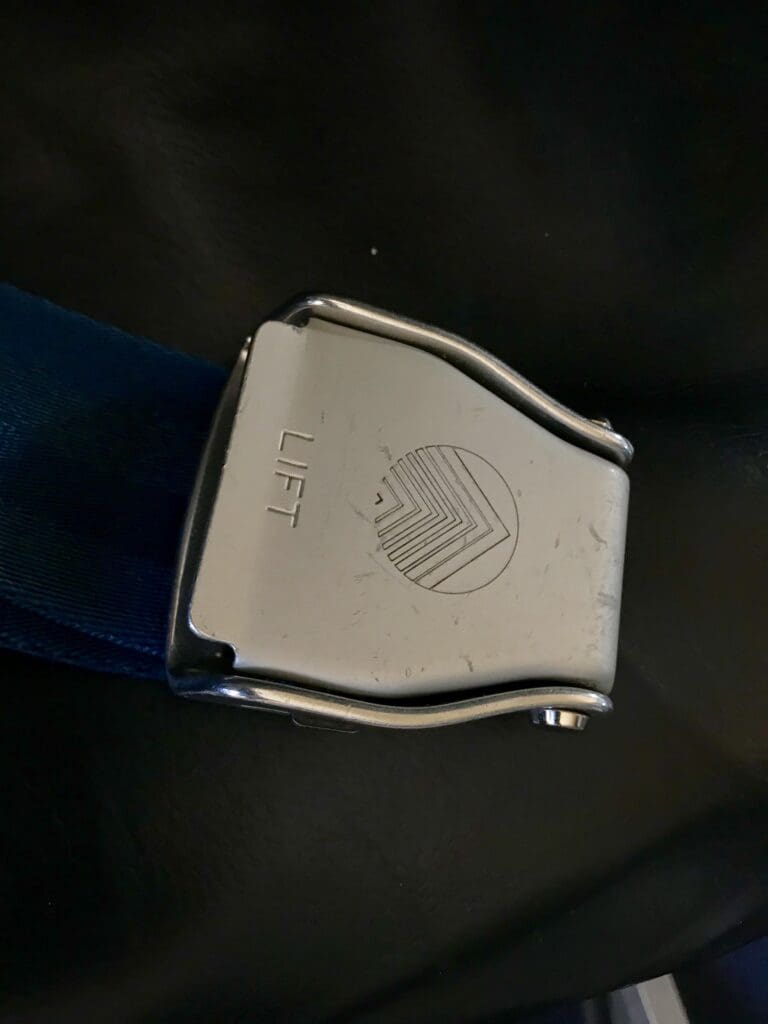

With Meridiana having retrofitted its McDonnell Douglas fleet with Recaro seats and with the cabin appearing to be in surprisingly good condition for its age with few signs of wear and tear (other than my rather scratched window), there was perhaps little to indicate to non-enthusiasts that the aircraft was on the older side of things. Each seat was covered in a dark (faux?) leather cover and came with a tray table and literature compartment, the latter containing the usual safety card and sickbag alongside the airline’s magazine and an Audi promotional booklet. Meanwhile, each seat also featured a fabric antimacassar on which Meridiana’s motif had been embroidered. Adding a nice extra level of customisation, this motif could also be seen on the cabin bulkheads and engrained into the aircraft’s seatbelt buckles. Once I was seated and had settled in for the ride, I found the seat to be nicely cushioned and offered a decent amount of legroom, whilst the area around this was clean and tidy, thereby leaving me with absolutely no complaints.



Given the delayed start to boarding and the fact that passengers had to be shuttled to the aircraft by bus, unsurprisingly boarding ended up concluding behind schedule, with all passengers not taking their seats until about 0930, ten minutes after our scheduled departure time. Looking around, the load onboard seemed to be no more than about 60% and it seemed that many passengers were seated upfront rather than in the rear half of the cabin. In terms of demographics, it seemed that many of those around me came in the form of Sardinian holidaymakers off to see the sights of London, with plenty of couples and families. Unsurprisingly, all crew members appeared to hail from Italy, and, having caught a glimpse of the cabin crews’ MD-80 branded baggage tags, it seemed that they were particularly proud to work onboard this rare aircraft type.


Almost as soon as the last passenger had boarded the aircraft, the Captain performed their welcome speech in Italian and English, however, seeing as the rear door remained open at this time, the noisy APU meant that this announcement was all but inaudible, although I assume that this featured the usual welcomes and thanks. Upon coming to an end, a loud whine could be heard followed by a thump as the stairs were retracted the rear door was closed. This meant that for a few minutes, the cabin quietened down, at which point the Purser performed their welcome and safety announcement. However, whilst going through the safety instructions in English, the two classic Pratt & Whitney JT8D-200 engines on either side fired up into life, resulting in screeching and humming being produced in surround sound and ensuring that the last minute or so of the safety instructions could not be heard.
Once the safety demonstration came to an end, the crew passed through the cabin ensuring all was in place for our departure before the flaps were partially extended and the aircraft powered forwards out of its parking position. From the stand, the aircraft did not have too far to travel until reaching the end of Runway 23 from where it would depart. As we trundled over to the runway, decent views of the wooded hills on the south side of the airport could be seen alongside taller hills and several of Sardinia’s mountains in the distance. Meanwhile, for those on the port side of the aircraft, the view would have been a little more aviation themed with vistas taking the form of Meridiana’s maintenance area and a couple of lifeless Metroliners that had once operated for the long-defunct ItAli Airlines.



Given Olbia’s status as Italy’s seventeenth busiest airport, it did not come as too much of a surprise to find that absolutely no holding was necessary before the McDonnell Douglas jet powered onto the runway. Without stopping, at 0940 the cabin was filled with noise as the two classic engines powered up causing us to go accelerating down the runway in what turned out to be a rather powerful departure. Soon, the pencil jet rotated upwards into sunny Sardinian skies, with a birds eye view of the near-empty remote stands and private jet terminal seen before the aircraft crossed over the airport’s perimeter fence.
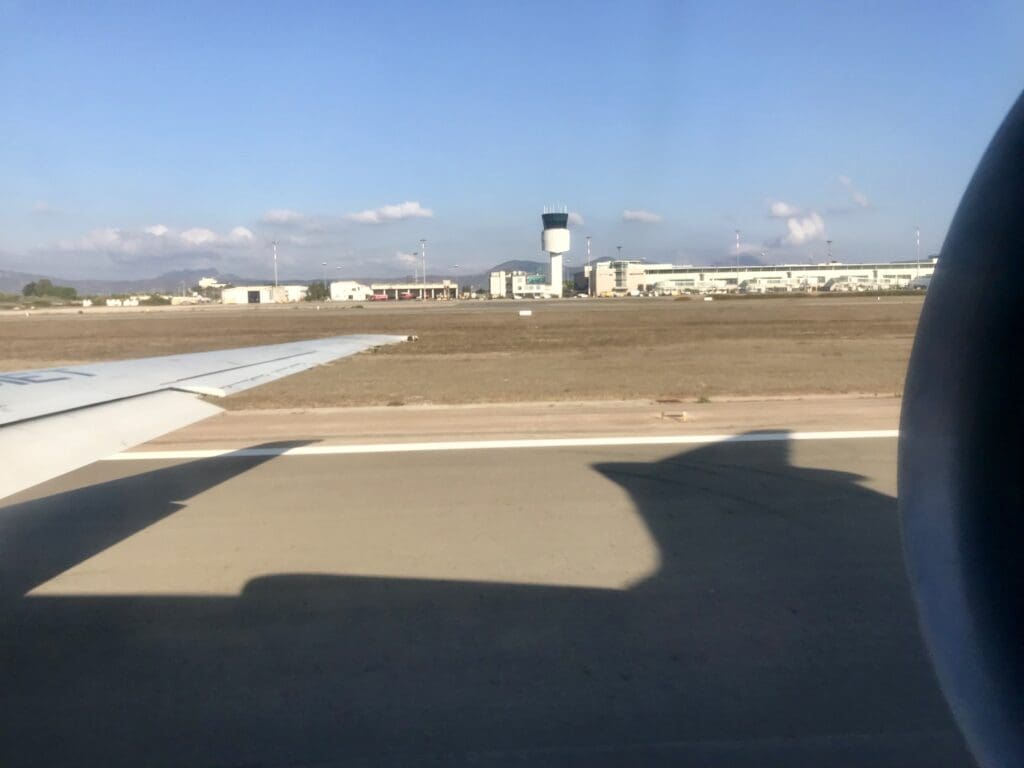


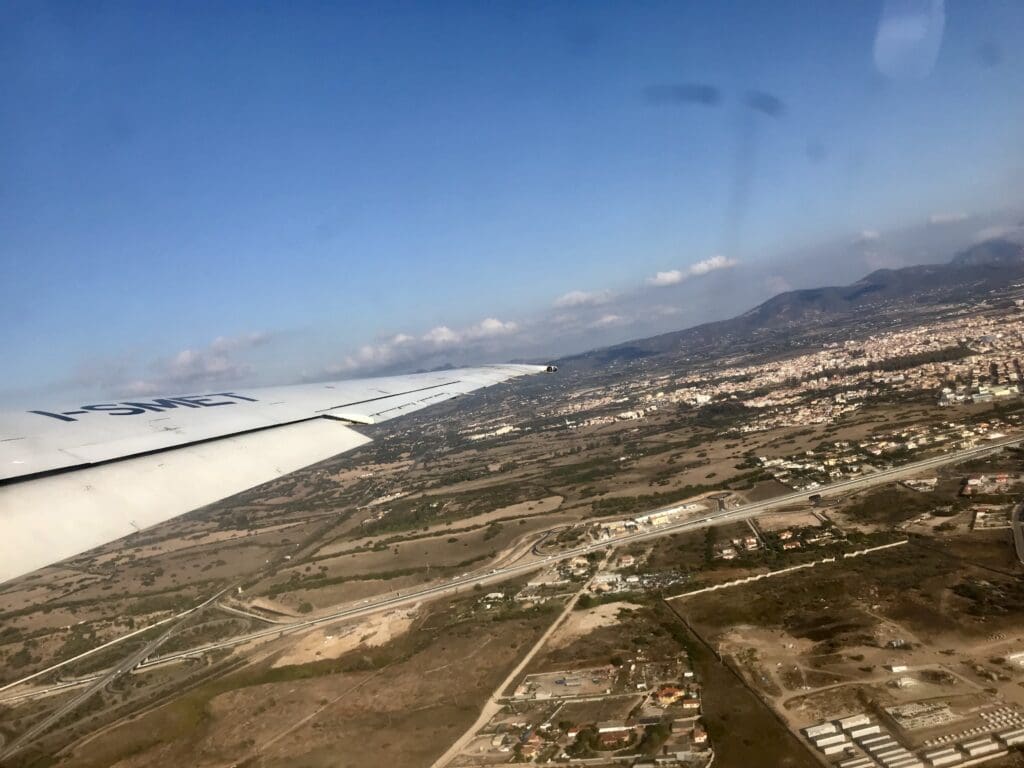


Once away from the airport, the McDonnell Douglas continued on its shallow climb over the rocky hills that surround Olbia, making a shallow turn northwards, pointing us in vaguely the correct direction for London. Despite the fantastic views that passengers were treated to during the initial climb out, soon, the aircraft climbed through a thin layer of cloud which stole away any final glimpses of Sardinia. Thankfully, the clouds dissipated by the time we reached 17,000 feet, revealing the blue waters of the Strait of Bonifacio which separates Sardinia from its smaller French neighbour, Corsica.


As the aircraft levelled off at 34,000 feet and sped northwards through the Corsican skies, fantastic views of the island’s spectacular rocky and jagged mountainous scenery could be had. Soon, I spotted Monte Cinto, Corsica’s tallest mountain which stands at 8,878 feet tall and theoretically offers views as far away as Monte Rosa which sits on the border between Italy and Switzerland! With this being my first time catching sight of Corsica, the impressive mountains and deep valleys left me with an good impression and I ended up putting this on my ‘must visit’ list! After these wonderful Corsican views, the clouds rolled in as the aircraft made a quick crossing of the Mediterranean Sea.



Inside the cabin, once the seatbelt signs had been extinguished, several crew members soon got to work in the aircraft’s small half-galley just opposite my seat, chatting loudly as they did this in order to be heard over the two engines. At 1000, two service carts were rolled out the aisle and the crew began the morning service from the front of the jet. Serving passengers rather quickly and thanks to the light load, it took no more than ten minutes until the crew reached me, the rearmost passenger. Soon, a polite and friendly crew member offered me either a cheese or a turkey sandwich, along with coffee, juice or water. Opting for the turkey sandwich with a coffee, I found this offering to be rather delicious and sufficient enough given the short length of the flight. Having done my research, I was expecting some sort of complimentary offering, however, I expecting little more than a drink and a biscuit, my expectations were exceeded.
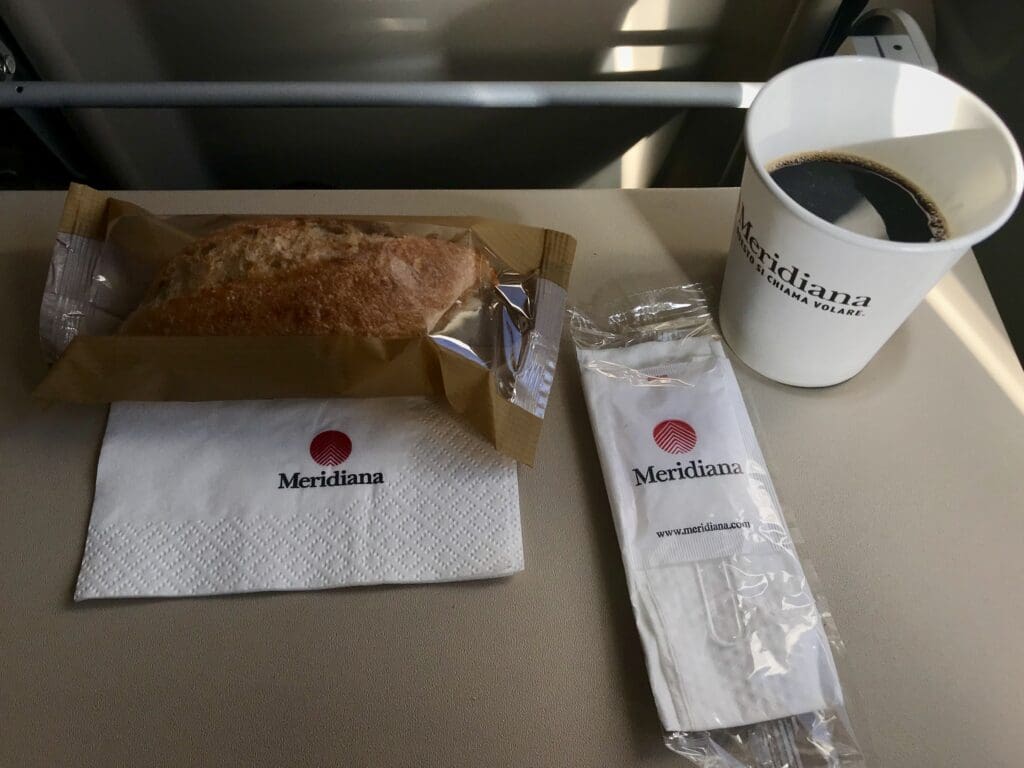
Turning my attention to the outside world once again, around fifteen minutes after leaving Corsica, the clouds opened up and revealed France’s Cote d’Azur. Crossing the French coastline between Cannes and Nice, nice views were offered of parts of Nice and Monaco before the aircraft headed inland. Soon, the urban sprawl that sits near the Mediterranean coastline transferred into green mountains before rising up once more and transforming into the jagged mountains of the Mercantour National Park, located on the border with Italy.



From this national park, the McDonnell Douglas jet made a smooth journey up to Grenoble as the mountains below increased in size as we passed over the Écrins National Park. There, mountains such as the 12,946 foot tall Mont Pelvoux and La Meije which stands at 13,071 feet could be spotted as well as several alpine glaciers. Between the mountains, the popular winter sports gateway of Chambéry could be seen and from there the landscape gradually sank and became greener before the cloud came in and blocked views of France.






With little to see outside, I turned to the airline’s only form of inflight entertainment, the October 2017 edition of Meridiana’s bilingual ‘Atmosphere’ inflight magazine. This contained the usual diverse selection of advertisements, travel articles and information about the airline. As I discovered from this, those flying on Meridiana’s ‘new’ Boeing 737-800s could enjoy various musical channels, whilst those heading a little further afield on one of the airline’s Boeing 767-300 were given several more entertainment options. Those in Economy could enjoy three films on the overhead screens (at the time of my flight these consisted of Going In Style, Hidden Figures and 42), whilst the privileged few flying in the comfort of the airline’s business, or, ‘Electa Class’ were offered iPads stocked with a wider range of content.

As the aircraft ploughed northwards up France’s eastern regions, the flight continued without the slightest jolt of turbulence. Meanwhile, the clouds seemed to continuously come and go beneath the aircraft offering occasional views of green fields, forests and small towns. Despite the engines’ loud hum, having failed to sleep much, I drifted off for a good twenty minutes and by the time I woke up, the aircraft was nearing Paris. Unfortunately, omnipresent cloud cover at this time ensured that no view of the French capital could be had although above the clouds I spotted a British Airways Airbus A320 making its way from Geneva to Heathrow as well as a KLM Boeing 737-800 passing overhead in the opposite direction on its journey to Barcelona.


From Paris the aircraft headed towards the department of Somme in Northern France, passing just to the west of Amiens at which point the Captain undertook a barely audible announcement offering an update on our progress. After a few minutes, for the first time during the flight, the amount of noise produced by the two engines decreased as we commenced our descent. Seeing as there was not a great deal of the flight remaining, I decided to visit one of the three lavatories onboard, two of which sit at the rear of the aircraft with another squeezed in next to the cockpit. As was to be expected, the lavatory was a little old fashioned and similar in aesthetic to similarly aged types such older Boeing 737 Classics. However, I found this to be clean and stocked with the basics, and, like the rest of the cabin, came with surprisingly few signs of wear and tear. My only slight complaint was that both taps only seemed to spew out cold water, although this was not too much of an issue.


At 1113, the aircraft crossed over the town of Abbeville and headed out over the Bay of the Somme towards the dark blue waters of the English Channel. Following a temporary gap in the clouds, all views were once again taken away as we headed towards the UK, meanwhile, the engines continued to provide a significant yet fluctuating amount of noise as if power was continuously being added and taken away during the descent. After a nine-minute crossing of the Channel, the aircraft crossed the British coastline near the historic East Sussex town of Hastings, famous for its battle in 1066 where the forces of King Harold were defeated by the armies of William of Normandy. Around twenty minutes after the aircraft had commenced its descent over northern France, the aircraft sank into the clouds at around 5,000 feet near the town of Tunbridge Wells before commencing a shallow bank to the left that would line the aircraft up for an approach to Gatwick’s Runway 26L.


Following the smooth flight up from Italy, the first notable patch of turbulence occurred as the aircraft began to sink into the thick layer of cloud. However, fortunately for those who aren’t too keen on being thrown about, this turbulence could not be described as anything more than a few gentle bumps. As the aircraft continued its descent, it became obvious that the British weather that morning stood in contrast to the sunshine we had left behind in Sardinia, with full flaps and the aircraft landing gear being extended whilst still in the clouds. Eventually, the rural Sussex countryside appeared below consisting of fields, farms, and the odd village before the stereotypical views of rural England were replaced by large car parks, industrial estates and airport related buildings before we crossed over the London to Brighton rail line and the airport’s perimeter fence.

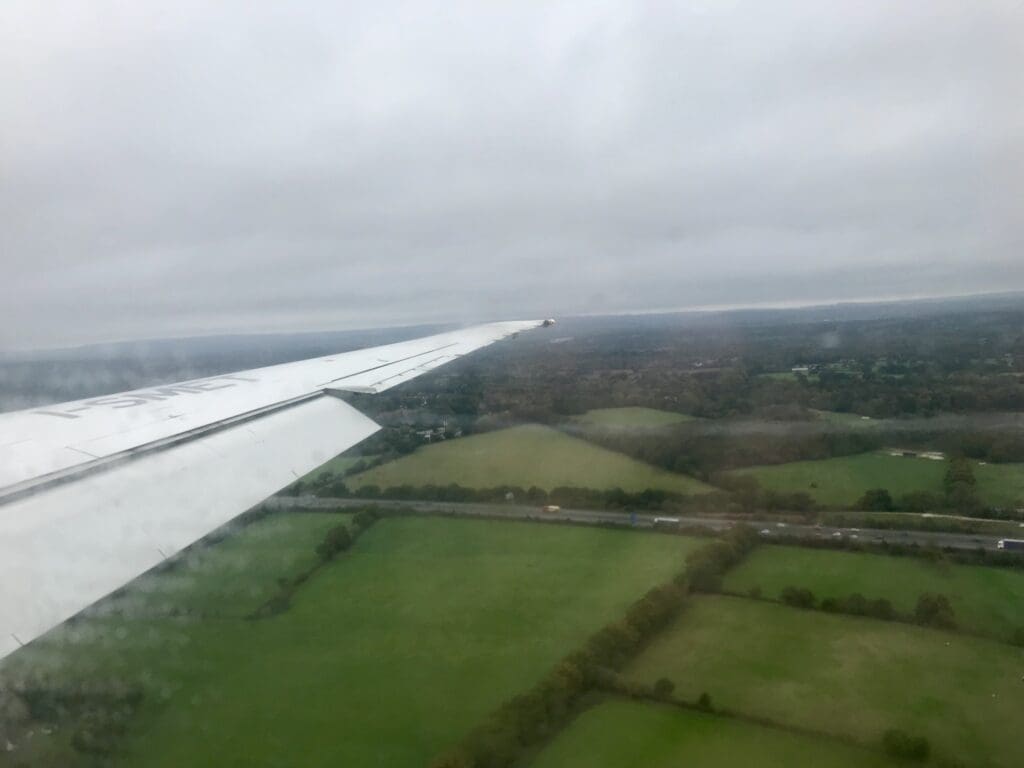
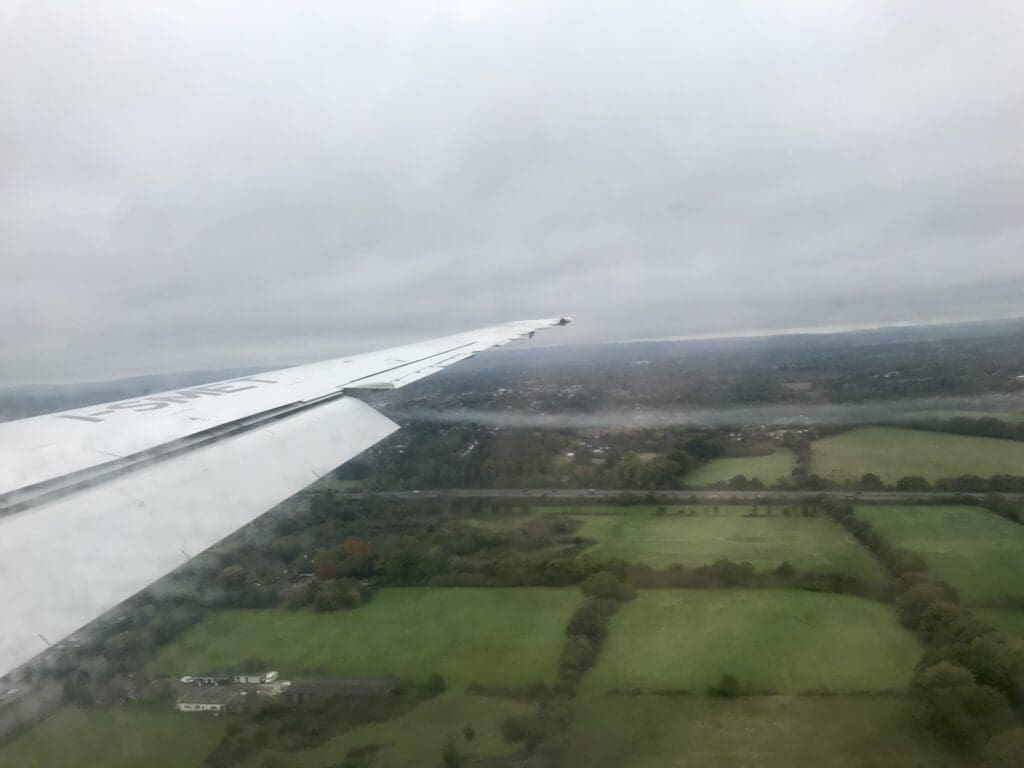
A little under two hours after departing Olbia, at 1038 local time, the aircraft made a smooth landing on Gatwick’s Runway 26L which was followed by the rather noisy application of the reverse thrust and some gentle braking. As we slowed, several Qatar Airways Airbus A320s could be seen waiting at remote stands, with these having been undertaking rescue flights for those unfortunate tourists that had been stranded following the collapse of British leisure giant Monarch Airlines. Once on the ground, the McDonnell Douglas MD-82 ended up travelling down almost the entire length of the runaway before vacating this to the right and commencing its journey to the terminal.




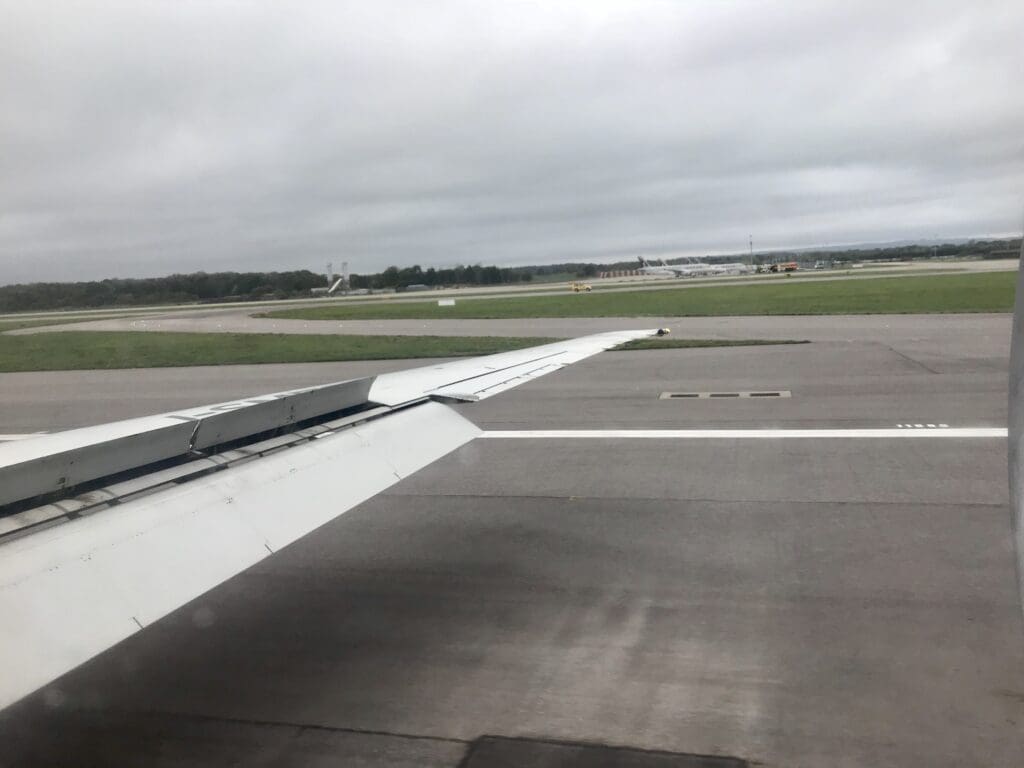
During the journey over to the North Terminal, I caught a glimpse of another, slightly older Italian registered McDonnell Douglas MD-82 that once flew for airline ItAli Airlines. Unfortunately, this jet appeared to be in a sorry and weathered state, missing its engines and other vital components, with this aircraft having not flown since 2010 when it had been impounded at Gatwick Airport. On a slightly related side note, back in 2010, the now-defunct Bangladeshi carrier United Airways operated a McDonnell Douglas MD-83 on a twice-weekly service between Sylhet to Gatwick, with this aircraft undertaking stops in Dhaka, Dubai and Istanbul on its long journey between Bangladesh and the UK!

Back to the present, outside, during the taxi a Turkish Airlines Boeing 737-800 could be seen touching down after its flight from Istanbul just before our aircraft turned into the area that hosts many of the airport’s remote stands. There, the aircraft passed a sleek Cathay Pacific Airbus A350 resting during its long turnaround along with a SmartLynx Airbus A321 sporting the basic livery of Thomas Cook Airlines. Continuing onwards, the McDonnell Douglas headed to the North Terminal and passed under Gatwick’s famous bridge before turning left into Stand 49 near the far end of the terminal.

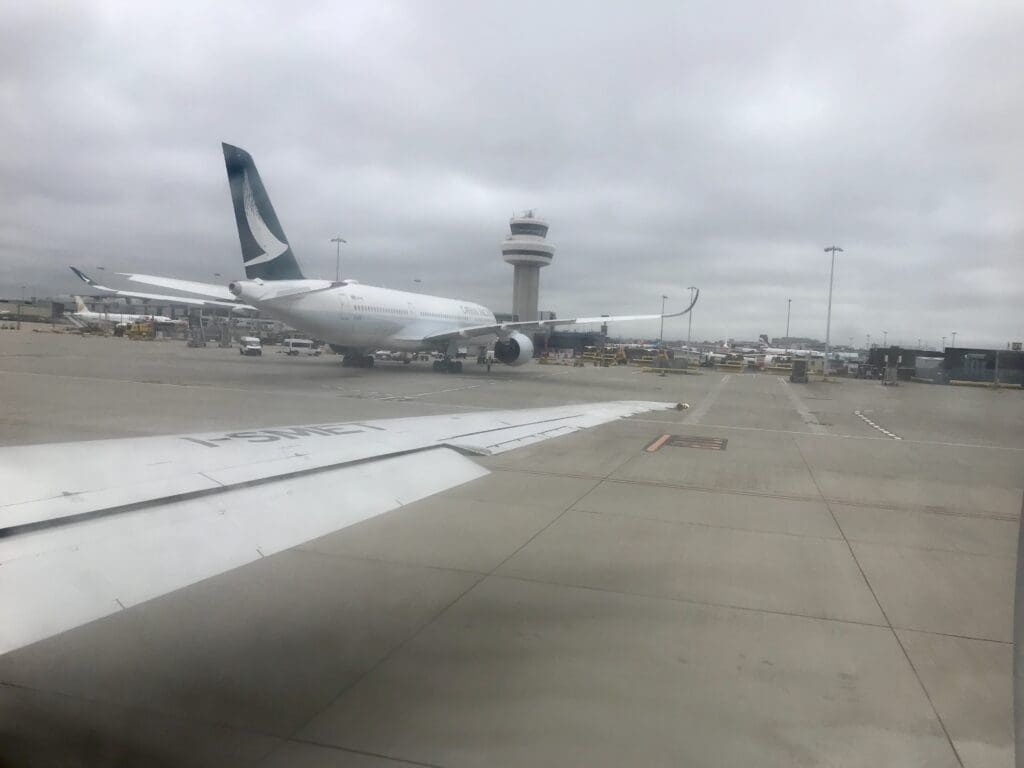
As the aircraft edged into the gates, many onboard seemed to jump up, obvious to the fact that the aircraft was still moving. Meanwhile, the crew who had been chatting away during the descent seemed to spend this time on their phones. Once the two engines spooled down, the crew opened the door at the rear of the aircraft however sadly, this could not be used for disembarkation. Being in no major rush to disembark, I waited for the queue in the aisle to subside before I stood up and made my way through the cabin before I thanked the Purser and stepped onto the chilly jetway around fifteen minutes following the aircraft’s touchdown.


After snapping a few quick pictures of the aircraft, I headed up into Gatwick Airport’s very 1990s-style North Terminal and made the long walk to immigration. At that time in the morning, the immigration hall was relatively empty and I was able to reach one of the immigration e-gates without any queuing and made it to the landside area rather quickly. With no luggage, once here I caught the busy automated train to the South Terminal and made it to the mainline railway station at 1115 with fifteen minutes to spare before my train to London Bridge.



Summary
Were it not for their rare McDonnell Douglas MD-80s, I would have been unlikely to fly with Meridiana. However, despite this, I was left incredibly pleased with the service I had received onboard. That morning all members of the crew that I had interacted with were polite and friendly, whilst the light breakfast service had proven to be a more than welcome addition to the flight. Sadly, whilst I will never fly with Meridiana again, I can look back fondly on my first and last experience with the Sardinian carrier.




